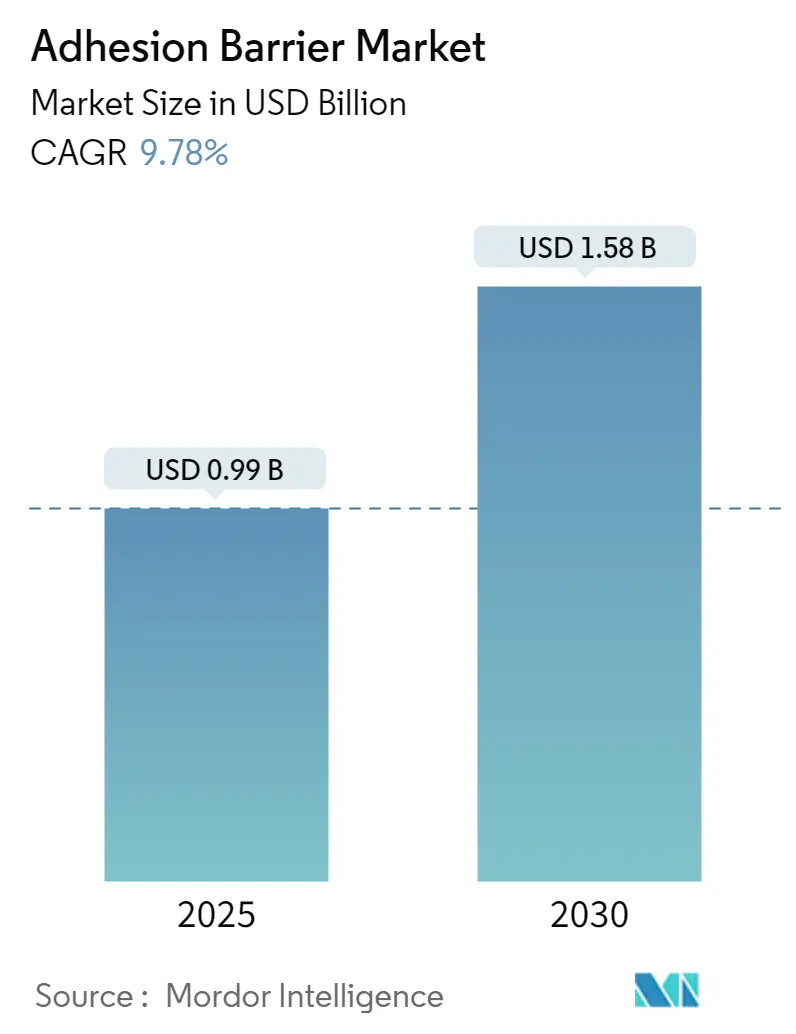
| Study Period | 2019 - 2030 |
| Base Year For Estimation | 2024 |
| Market Size (2025) | USD 0.99 Billion |
| Market Size (2030) | USD 1.58 Billion |
| CAGR (2025 - 2030) | 9.78 % |
| Fastest Growing Market | Asia Pacific |
| Largest Market | North America |
Major Players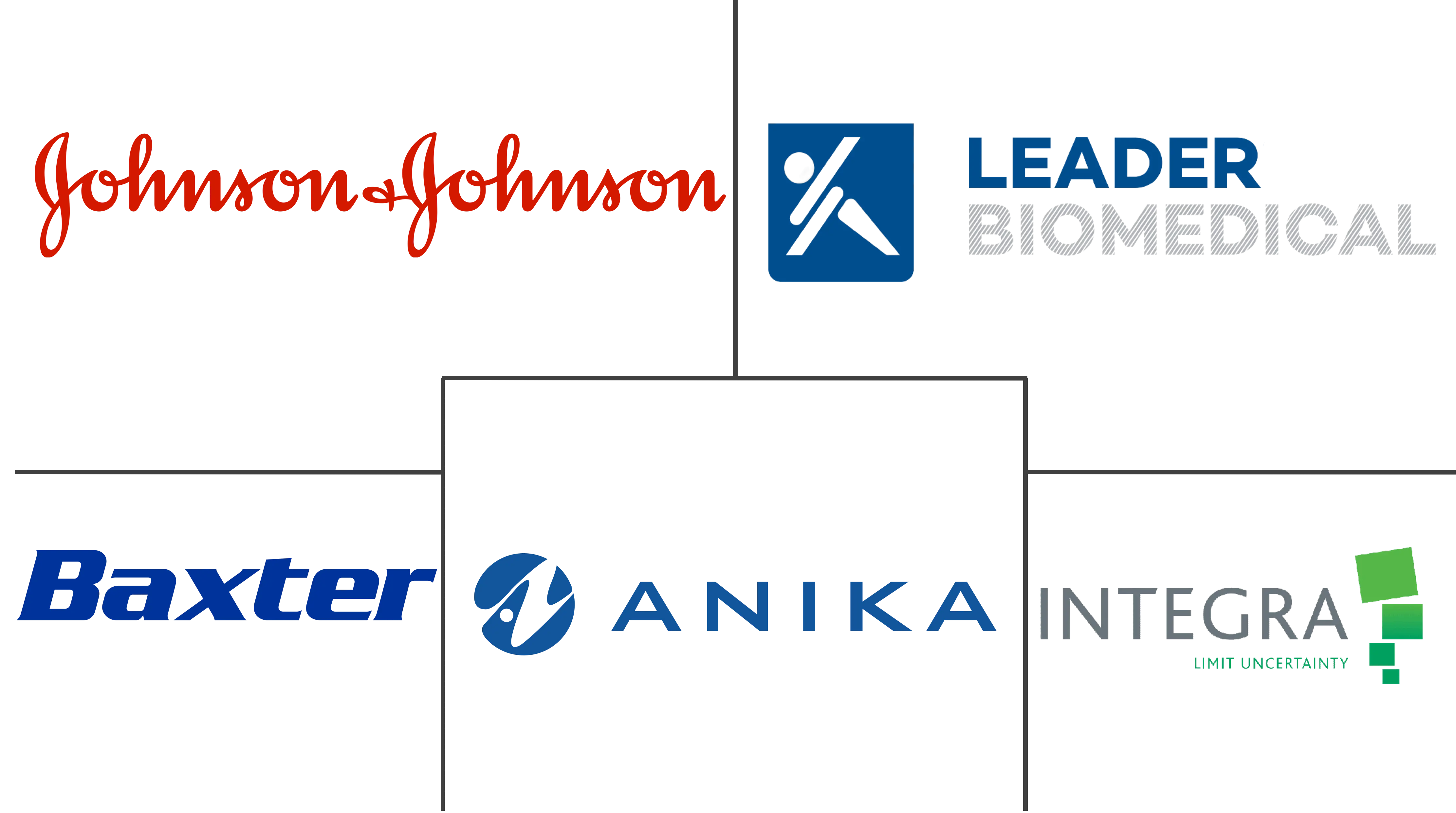
*Disclaimer: Major Players sorted in no particular order |
Adhesion Barrier Market Analysis
The Adhesion Barrier Market size is estimated at USD 0.99 billion in 2025, and is expected to reach USD 1.58 billion by 2030, at a CAGR of 9.78% during the forecast period (2025-2030).
The pandemic had a significant impact on various surgical procedures initially, as there were strict guidelines specific to each specialty that was implemented and followed by surgeons to continue to provide safe and effective care to their patients during the COVID-19 pandemic. For instance, according to an article published by BMJ Journal in June 2021, surgical programs suspended various non-urgent or elective surgical procedures worldwide during the pandemic. These changes considerably impacted patients, providers, and healthcare organizations. Thus, reducing surgical procedures during the COVID-19 pandemic negatively impacted the market's growth in 2020. However, the postponed surgeries resumed during the post-pandemic period, which boosted the market's growth. As the pandemic has subsided, the studied market is expected to grow significantly over the forecast period. Specific factors driving the market growth include increased surgeries and sports-related injuries and rising awareness about the medical implications of adhesions.
According to the data published by British Heart Foundation in December 2021, an estimated 32,938 completed heart operations and other heart procedures were performed in England in October 2021. As adhesion barriers are used after surgeries, increasing operations and surgeries are expected to require adhesion barriers to reduce scars. Therefore, the market is expected to surge over the forecast period.
Moreover, a growing number of surgical procedures due to sports injuries, accidents, and orthopedic surgeries are primary factors driving the adhesion barrier market. There is a high prevalence of orthopedic diseases and other chronic conditions where surgery is suggested as mandatory. According to the data published by the National Safety Council (NSC) for the United States in 2021, bicycling accounted for about 375,797 injuries, and exercise accounted for about 409,224 injuries. The injuries due to an all-terrain vehicle (ATV), moped, and minibike were 238,404, and those due to skateboard, scooter, and hoverboard were 245,177. Therefore, an increasing number of injuries is expected to propel the growth of the adhesion barrier market globally.
Healthcare in developing countries is undergoing rapid changes. The growing population in these countries will likely lead to increased demand for medical devices. The growing burden of diseases and innovative medical treatments contributed to nearly two-thirds of the rise in spending. Spending on healthcare in developing countries is expected to increase during the forecast period. According to the data published by the Office for National Statistics of the United Kingdom in May 2022, the estimated total healthcare expenditure in 2021 was GBP 277 billion (USD 373.4 billion), which increased by 7.4% when compared to the spending in the last year. Specific investments in the healthcare sector offer attractive long-term financial benefits. Medical care is one area where individuals tend to increase spending as incomes grow. Hence, with the increasing healthcare expenditure, the adoption of advanced products, such as adhesion barriers for surgeries, is expected to increase. Thus the studied market is expected to experience growth during the forecast period of the study.
Therefore, due to the aforementioned factors, such as the increased volume of surgeries and sports-related injuries, increasing healthcare expenditure, and rising awareness about the medical implications of adhesions, the studied market is expected to experience growth. However, the high cost of surgical procedures coupled with side effects associated with adhesion barriers and stringent regulations resulting in limited technological innovations are expected to restrain the growth of the adhesion barrier market.
Adhesion Barrier Market Trends
Gynecological Surgeries Segment Expected to Witness Growth
The adhesive disease represents a significant cause of morbidity for postoperative patients. Adhesion barriers have been proven to reduce adhesion-related complications in gynecological surgery. The use of adhesion barriers in open surgery is cost-effective in preventing adhesion-related problems.
According to the WHO updates from June 2021, cesarean section procedures are continuously rising globally, accounting for more than 1 in 5 (21%) childbirths. Moreover, several countries are also experiencing a rise in surgical procedures owing to the rising burden of non-communicable diseases and injuries. Furthermore, per the data published by CDC in July 2022, the cesarean delivery rate increased to 32.1% in the United States in 2021. Cesarean delivery is an abdominal surgery that requires the use of adhesion barriers.
Furthermore, according to an article published by the Journal of Obstetrics and Gynaecology in August 2021, adhesion formation after gynaecologic surgeries is widespread and highly problematic as it directly induces complications and makes subsequent surgeries more difficult. Adhesion barriers to overcoming this problem have proven safe and effective. Adhesion barriers help in significantly reducing both adhesion extent and severity in comparison to untreated control.
Thus, the segment is expected to witness significant growth over the forecast period due to the above-mentioned factors, such as increasing gynecological surgeries and increasing advantages of adhesion barriers in gynecological surgeries.
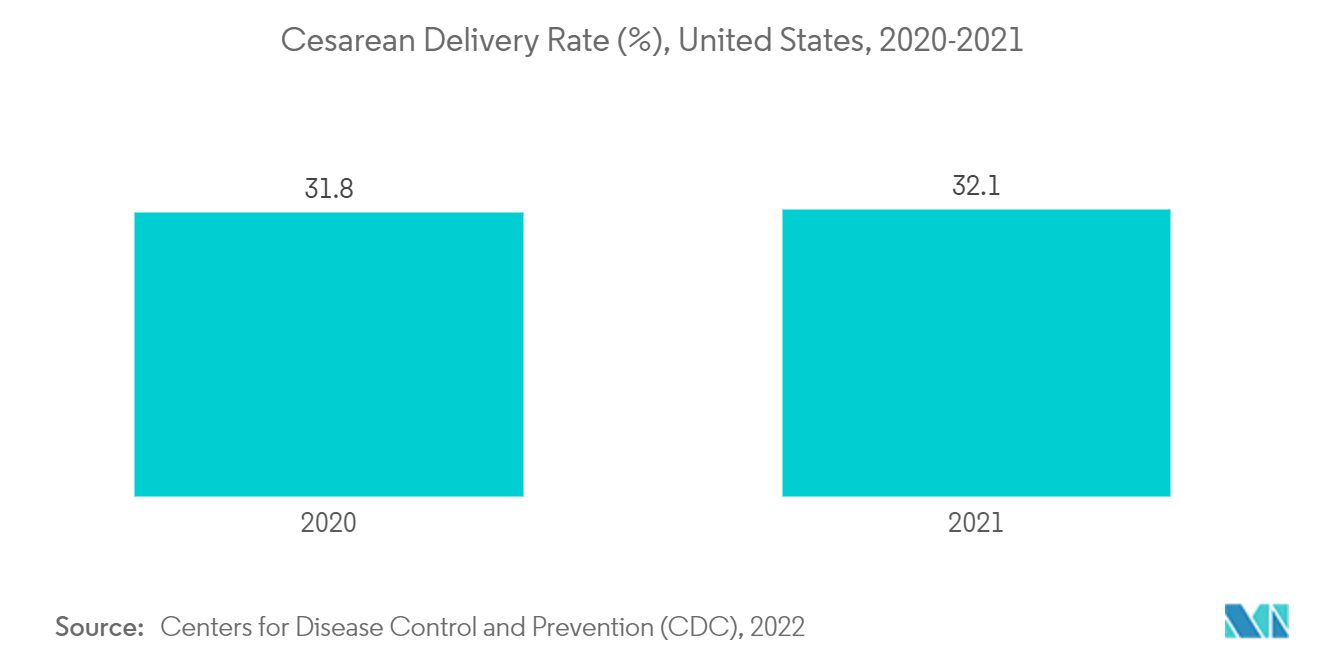
North America Anticipated to Hold a Significant Market Share
The increasing rate of surgery in the region has been well-documented. Market growth in North America is driven by technological advancement, elderly patients expecting higher levels of function, and reimbursement models incentivizing complex fusion surgery. Adhesion barriers are also valuable for oncology surgeries. Furthermore, growing awareness among the population to approach surgical procedures in case of injuries and chronic disease problems is also driving market growth.
The rising number of orthopedic procedures within the North American region will likely positively impact market growth. For instance, according to the data published by the American Academy of Orthopedic Surgeons in November 2022, an estimated 2,550,232 primary and revision hip and knee arthroplasty procedures were performed in the decade in the United States. It showed a cumulative procedural volume growth of 14% compared to the previous year. As adhesion barriers are used for orthopedic procedures, the increasing number of hip and knee arthroplasty procedures is expected to enhance the market growth.
Additionally, according to the data published by National Safety Council (NSC) in 2021, an estimated 11.7 million people were treated in emergency departments of the United States for injuries resulting from consumer products. Most injuries involve everyday products that are often assumed to be safe. Many injuries occur to vulnerable populations such as older adults and young children. According to the Canadian Institute of Health Information data in February 2022, the most common inpatient surgery in Canada in 2021 was a cesarean section (C-section). This is expected to increase the adoption of adhesion barriers. Thus, the increasing number of injuries that require medical attention and a growing number of surgeries is further expected to boost the market in the region over the forecast period.
Thus, all the aforementioned factors, such as the rise in injury cases and the rising number of orthopedic surgeries, are expected to boost the market in the region.
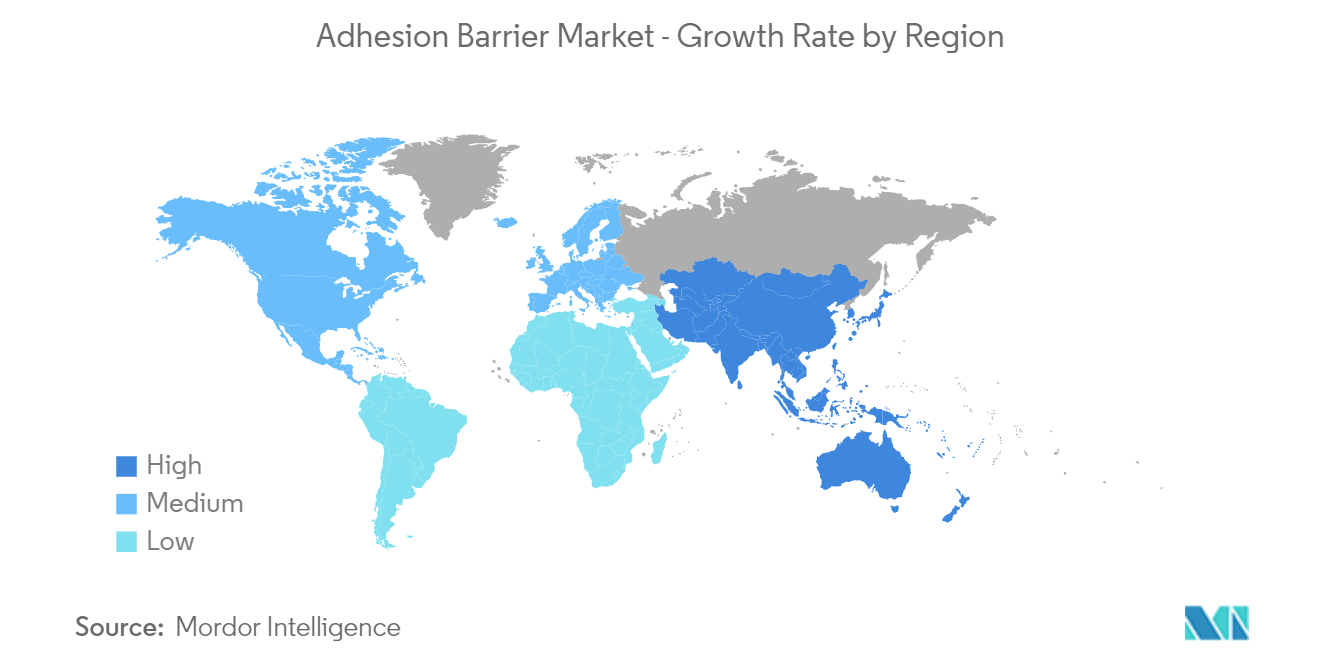
Adhesion Barrier Industry Overview
The adhesion barrier market is moderately competitive and consists of several major players. Companies such as Anika Therapeutics, Baxter International, Leader Biomedical, Betatech Medical, FzioMed, Integra LifeSciences Holdings Corporation, Johnson & Johnson, and MAST Biosurgery, among others, hold a substantial market share in the adhesion barrier market.
Adhesion Barrier Market Leaders
-
Johnson & Johnson
-
Leader Biomedical
-
Anika Therapeutics
-
Integra LifeSciences Holdings Corporation
-
Baxter International
- *Disclaimer: Major Players sorted in no particular order
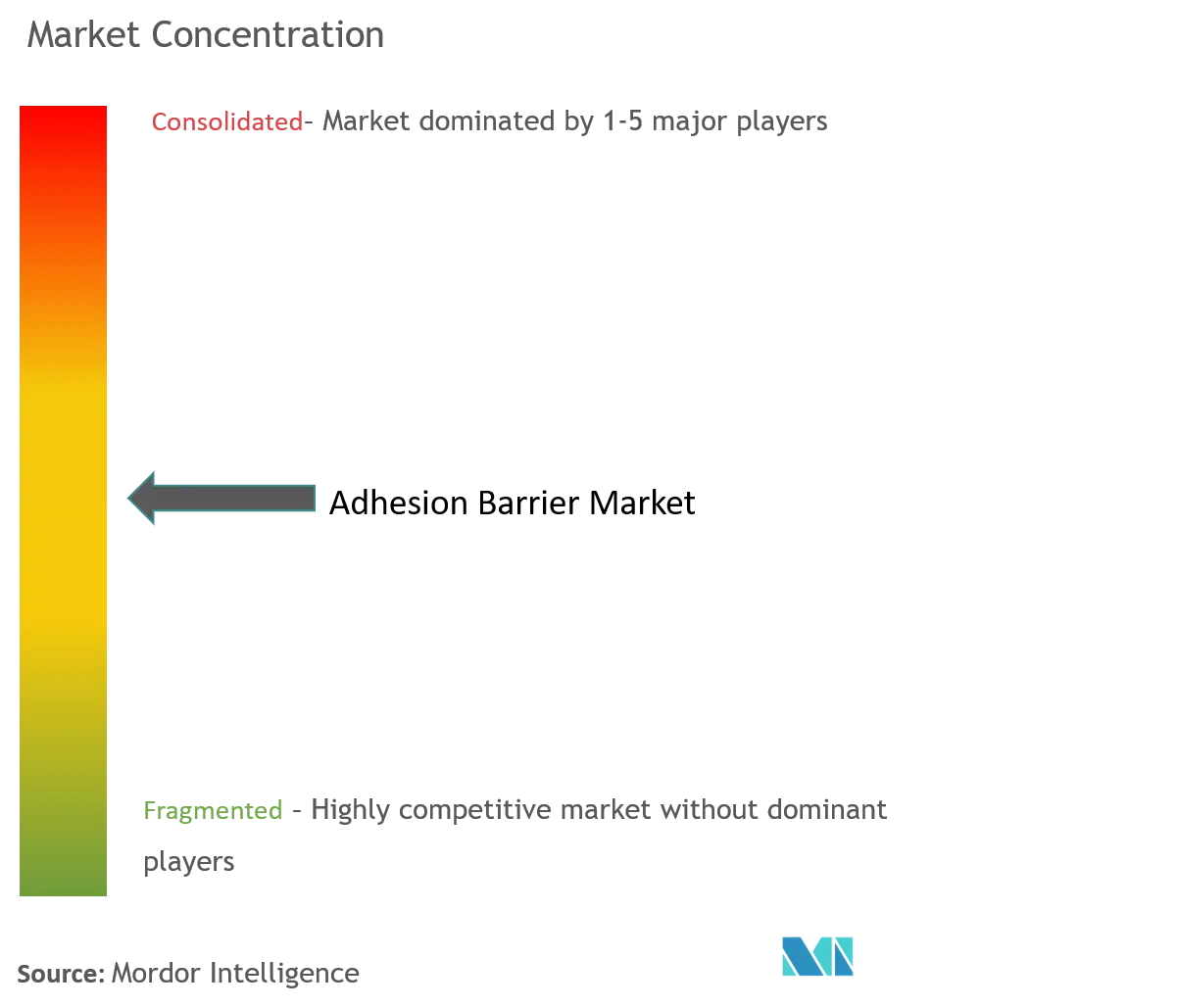
Adhesion Barrier Market News
- June 2022: CGBIO launched MEDICLORE, an anti-adhesion agent in Indonesia. MEDICLORE inhibits adhesion by changing from sol to gel form by body temperature when applied to the body.
- February 2022: Gunze Limited obtained medical device approval to manufacture and sell TENALEAF, the first sheet-type absorbable adhesion barrier made in Japan.
Adhesion Barrier Industry Segmentation
An adhesion barrier refers to a medical implant that can be used to reduce abnormal internal scarring by adhesions following any surgery by separating the internal tissues and organs as long as they heal. It involves a proper surgical technique which is very much crucial to diminish adhesion formation.
The Adhesion Barrier Market is Segmented by Product (Synthetic Adhesion Barriers (Hyaluronic Acid, Regenerated Cellulose, Polyethylene Glycol, and Other Synthetic Adhesion Barriers) and Natural Adhesion Barriers (Collagen and Fibrin)), Formulation (Film, Liquid, and Gel), Application (General/Abdominal Surgeries, Gynecological Surgeries, Cardiovascular Surgeries, Orthopedic Surgeries, Neurological Surgeries, and Other Applications), and Geography (North America, Europe, Asia-Pacific, Middle East and Africa, and South America). The market report also covers the estimated market sizes and trends for 17 different countries across major regions globally. The report offers the value (in USD million) for the above segments.
| By Product | Synthetic Adhesion Barriers | Hyaluronic Acid | |
| Regenerated Cellulose | |||
| Polyethylene Glycol | |||
| Other Synthetic Adhesion Barriers | |||
| Natural Adhesion Barriers | Collagen | ||
| Fibrin | |||
| By Formulation | Film | ||
| Liquid | |||
| Gel | |||
| By Application | General/Abdominal Surgeries | ||
| Gynecological Surgeries | |||
| Cardiovascular Surgeries | |||
| Orthopedic Surgeries | |||
| Neurological Surgeries | |||
| Other Applications | |||
| By Geography | North America | United States | |
| Canada | |||
| Mexico | |||
| Europe | Germany | ||
| United Kingdom | |||
| France | |||
| Italy | |||
| Spain | |||
| Rest of Europe | |||
| Asia-Pacific | China | ||
| Japan | |||
| India | |||
| Australia | |||
| South korea | |||
| Rest of Asia-Pacific | |||
| Middle East and Africa | GCC | ||
| South Africa | |||
| Rest of Middle East and Africa | |||
| South America | Brazil | ||
| Argentina | |||
| Rest of South America | |||
Adhesion Barrier Market Research FAQs
How big is the Adhesion Barrier Market?
The Adhesion Barrier Market size is expected to reach USD 0.99 billion in 2025 and grow at a CAGR of 9.78% to reach USD 1.58 billion by 2030.
What is the current Adhesion Barrier Market size?
In 2025, the Adhesion Barrier Market size is expected to reach USD 0.99 billion.
Who are the key players in Adhesion Barrier Market?
Johnson & Johnson, Leader Biomedical, Anika Therapeutics, Integra LifeSciences Holdings Corporation and Baxter International are the major companies operating in the Adhesion Barrier Market.
Which is the fastest growing region in Adhesion Barrier Market?
Asia Pacific is estimated to grow at the highest CAGR over the forecast period (2025-2030).
Which region has the biggest share in Adhesion Barrier Market?
In 2025, the North America accounts for the largest market share in Adhesion Barrier Market.
What years does this Adhesion Barrier Market cover, and what was the market size in 2024?
In 2024, the Adhesion Barrier Market size was estimated at USD 0.89 billion. The report covers the Adhesion Barrier Market historical market size for years: 2019, 2020, 2021, 2022, 2023 and 2024. The report also forecasts the Adhesion Barrier Market size for years: 2025, 2026, 2027, 2028, 2029 and 2030.
Our Best Selling Reports
Adhesion Barrier Industry Report
The Adhesion Barrier Market is segmented by product, formulation, application, and geography. The market analysis reveals significant insights into synthetic adhesion barriers such as hyaluronic acid, regenerated cellulose, polyethylene glycol, and other synthetic adhesion barriers, as well as natural adhesion barriers like collagen and fibrin. The industry analysis highlights various formulations including film, liquid, and gel, which are used in general/abdominal surgeries, gynecological surgeries, cardiovascular surgeries, orthopedic surgeries, neurological surgeries, and other applications.
The market report provides an in-depth industry overview and market forecast, offering a comprehensive understanding of market size, market growth, and market trends. The industry research emphasizes the importance of market segmentation and the role of market leaders in driving the industry forward. The market outlook and industry outlook indicate a positive trajectory with substantial market value and market predictions.
According to industry reports, the market review and market data suggest a robust growth rate, supported by detailed industry statistics and market information. The report example and report PDF serve as valuable resources for research companies seeking to understand the market dynamics and industry sales.
The market forecast and industry research underline the significance of market segmentation and industry trends in shaping the future of the adhesion barrier market. The industry size and market overview provide a holistic view of the market landscape, while the market leaders continue to influence the industry with their strategic initiatives. The industry information and market predictions offer a clear perspective on the market growth and market outlook, ensuring that stakeholders are well-informed about the market's potential.
In conclusion, the adhesion barrier market is poised for significant growth, driven by advancements in product formulations and applications across various surgical procedures. The industry analysis and market review highlight the key factors contributing to the market's success, making it a valuable resource for industry stakeholders and research companies.




